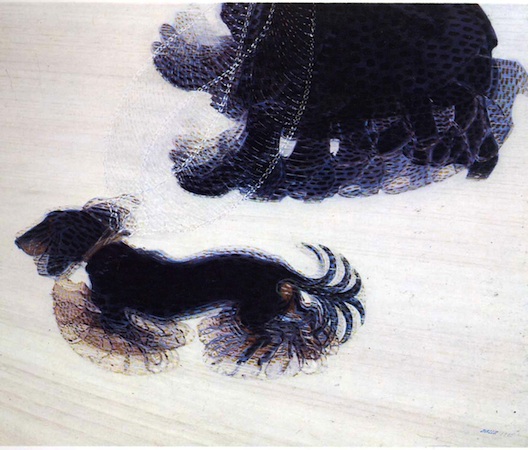Overview
In this blog essay
I am going to describe the characteristics and influences of the Futurism art
movement.
Futurism originated
in italy during the dawn of the 20th century, embracing the energetic dynamism
and power of the machine age. The movement was instigated by the writer Filippo
Tommaso Marinetti. Although it started off from literature, the radicality of
this movement quickly helped it to jump from painting to industrial design and
grow more popular. Its influence spread from the peninsula across most of
Europe and even as far as reaching out to Russian avante-garde. The movement
left the most significant impact on the visual arts and poetry (White, 1998). Futurist
artists were inspired by elements of Neo-Impressionism and Cubism, using them
to portray the fast-paced, dynamic themes of the new modernist lifestyle that
began to spread (Tate, 2009).
 |
| Marinetti accompanied by Futurism Artists |
The Influences of Marinetti’s Manifesto
In 1909, Marinetti published
his manifesto in the Italian newspaper La
Gazzetta dell'Emilia, as well as the
Parisian newspaper ‘Le Figaro’, in
which he stated the goals of the new movement which he announced. He wanted to
discard the art of the past and celebrate change, originality and innovation.
In his column, he glorified the new rising technology wth bombastic rhetoric
that was aimed to provoked controversy (White, 1998). Infact, he even struck
out against museums and libraries, calling for their destruction. This
manifesto swayed a group of young Milanese painters, which are:
Giacomo Balla, Umberto Baccioni, Carlo Carrà, and Gino
Severini
These young artists
signed up to their first Manifesto as early as 1910. Cubism had a major impact
on Marinetti and his new folks when they saw it in person for the first time (Casden,
2015).
Giacomo Balla’s Dynamism
 |
Giacomo Balla,
Street light – Study of Light,
1909, oil on canvas
|
Balla’s
art became heavily influenced by Étienne-Jules Marey’s chronophotographic
studies of human movement. Along with his fellow artists, they became obsessed
with motion and its dynamism. On the other hand, Balla was uniterested in machinery
and violence, but was instead a lyrical painter. His painting Street Light - Study Of Light is a great
example to illustrate this, conveying
the energy and momentum of modern life.
In his painting, The Dynamism Of A Dog On A Leash (1912), Balla captures several
instances but instead of portraying them separately, he masterfully combines those
instances into one simultaneous moment (Encyclopedia Britannica, 1998).
 |
Giacomo Balla, Dynamism of a Dog on a Leash,
1912, oil on canvas
|
Umberto Boccioni and Continuity
"Let us fling open the figure and let it incorporate
within itself whatever may surround it."
Umberto
Boccioni
 |
Umberto Boccioni,
Unique
Forms of Continuity and Space,
1913, Bronze
|
Unique Forms of Continuity and Space (1913) is a sculpture that does not depict the human figure as one
solid form but rather as multiple planes in spaces (White, 1998). Boccioni’s marching
figure symbolises sheer force and power in its long stride and its bronze silhouette
is distorted by imaginary wind and velocity. Its polished, aerodynamic surfaces
undeniably represents the sleek machinery of the age that he lived in (The
Museum of Modern Art, 2006). Its organic edges maintain continuity of the Futurist
theme throughout the entirety of its form.
After the War
However, after the
brutality that World War I inflicted upon the world, everyone began to shun
away the Futurist movement and other pre-war avante-garde notions as the bad
reputation of fascism had stuck onto them (Tate, 2009). Thus, the traditional
approach to art returned once again.
References
Casden, E. (2015). Italian Futurism: An
Introduction. [online] Khan Academy. Available at:
https://www.khanacademy.org/humanities/art-1010/wwi-dada/art-great-war/a/italian-futurism-an-introduction
[Accessed 4 Jun. 2017].
Encyclopedia Britannica. (1998). Giacomo Balla
| Italian artist. [online] Available at:
https://www.britannica.com/biography/Giacomo-Balla#ref106649 [Accessed 4 Jun.
2017].
Tate. (2009). Futurism – Art Term | Tate.
[online] Available at: http://www.tate.org.uk/art/art-terms/f/futurism
[Accessed 4 Jun. 2017].
The Metropolitan Museum of Art, i.e. The Met
Museum. (2017). Umberto Boccioni | Unique Forms of Continuity in Space | The
Met. [online] Available at:
http://www.metmuseum.org/art/collection/search/485540 [Accessed 4 Jun. 2017].
The Museum of Modern Art. (2006). Umberto
Boccioni. Unique Forms of Continuity in Space. 1913 (cast 1931) | MoMA.
[online] Available at: https://www.moma.org/collection/works/81179 [Accessed 4
Jun. 2017].
White, J. (1998). Futurism | the arts.
[online] Encyclopedia Britannica. Available at:
https://www.britannica.com/art/Futurism [Accessed 4 Jun. 2017].
Comments
Post a Comment